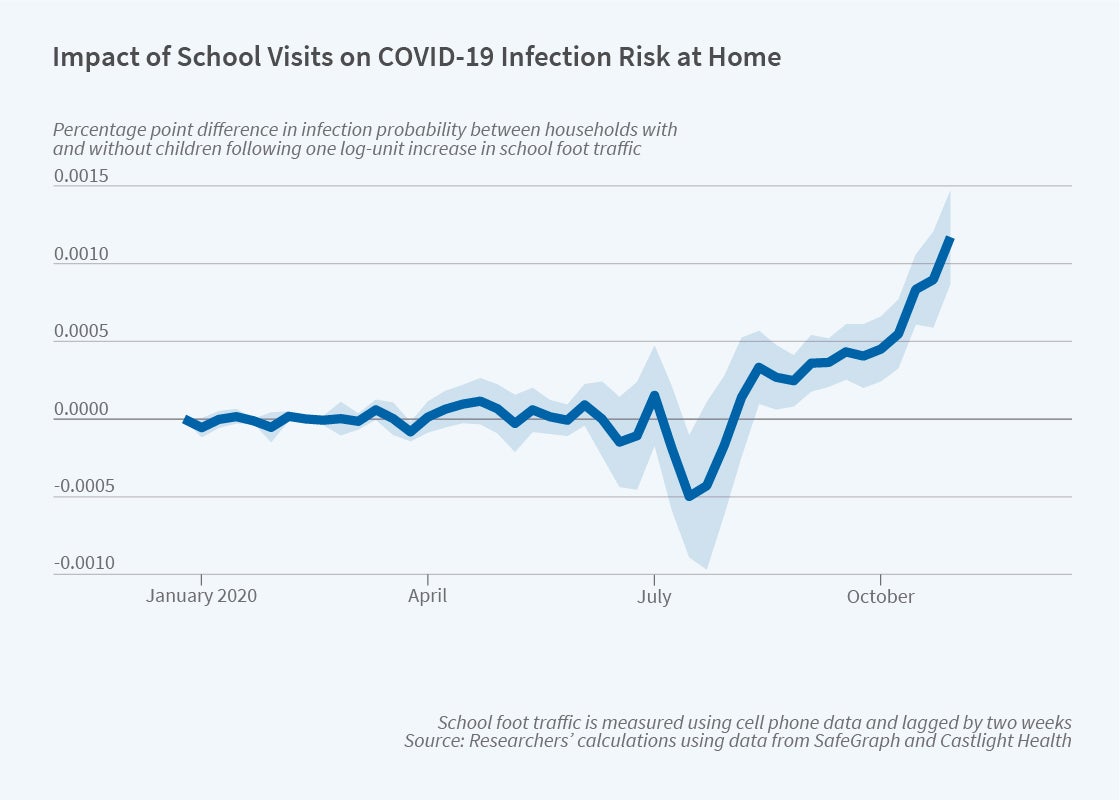School Reopenings Contribute to Modest, but Heterogeneous, Rise in COVID-19 Transmission

Uncertainty about the risk of COVID-19 transmission from school reopenings has confounded educational decision-making during the pandemic. Research on this topic has been affected by research design complications and a lack of data. In Back to School: The Effect of School Visits during COVID-19 on COVID-19 Transmission (NBER Working Paper 28645), researchers Dena Bravata, Jonathan H. Cantor, Neeraj Sood, and Christopher M. Whaley overcome several of these challenges to demonstrate that school reopenings on average cause a small rise in infection rates.
One difficulty in assessing the impact of school reopenings is the lack of consistent, nationwide data on school reopenings. The researchers address this issue by measuring actual movements in and out of school buildings, as tracked by mobile phones and reported by SafeGraph. This approach provides a measure of school reopenings, capturing the wide array of remote, in-person and hybrid schooling formats that school districts have employed during the pandemic. Their measure — the year-over-year change in the natural log of school visits in each county and week of 2020 — can be interpreted as the percentage change in school visits relative to the prepandemic benchmark.
Another analytical challenge in evaluating the impact of school reopenings on COVID-19 transmission is that school reopenings respond to local conditions, with schools more likely to open in areas experiencing low infection rates. The researchers address this concern by using household-level medical claims data, collected by Castlight Health. They compare the infection rate for households with school-aged children — who are more likely to face elevated transmission due to school reopenings — with that for households without school-aged children. Households without school-aged children provide a crucial control for local infection rates that are not directly attributable to school reopenings. The researchers note that, because their measure of infection rates relies on medical claims data, it may exclude some mild and asymptomatic cases.
In light of the incubation period for COVID-19, the researchers examine the relationship between their school visit measure and infection rates two weeks afterwards. Their analysis shows that increased visits to schools lead to a subsequent rise in diagnoses among households with school-aged children, relative to other households in the same counties and weeks. Overall, the magnitude of the increased transmission is modest. Specifically, a shift from the 25th percentile of school visits to the 75th percentile of school visits leads to a 0.0003 percentage point (or 3 in 10,000 persons, about 3 percent of the average infection rate) increase in the risk of COVID-19 infection in households with school-aged children.
School reopenings have slightly larger effects on pediatric diagnoses, but adults are also affected. These results suggest that school reopenings generate within-school transmission between children, as well as within-household transmission from children to adults. There is no evidence of increased infection rates for households headed by school employees.
The modest overall effect on infection rates masks important heterogeneity in the impact of school reopenings. As the figure shows, the impact varied over time, with substantially larger effects in the latter months of the year when overall infection rates in the US were relatively high. The impact is also concentrated in lower-income counties, suggesting socioeconomic disparities in the health consequences of school reopenings.
This research sheds important light on the magnitude of the health risks associated with increased school visits. As policymakers consider reopening strategies, these costs must be weighed against the educational and social benefits of in-person schooling.
The researchers acknowledge financial support from the National Institute on Aging Grant K01AG061274 and the Conrad N. Hilton Foundation.


